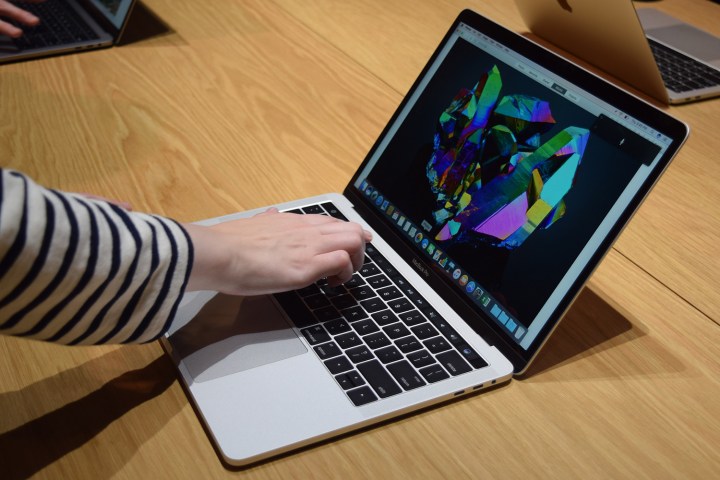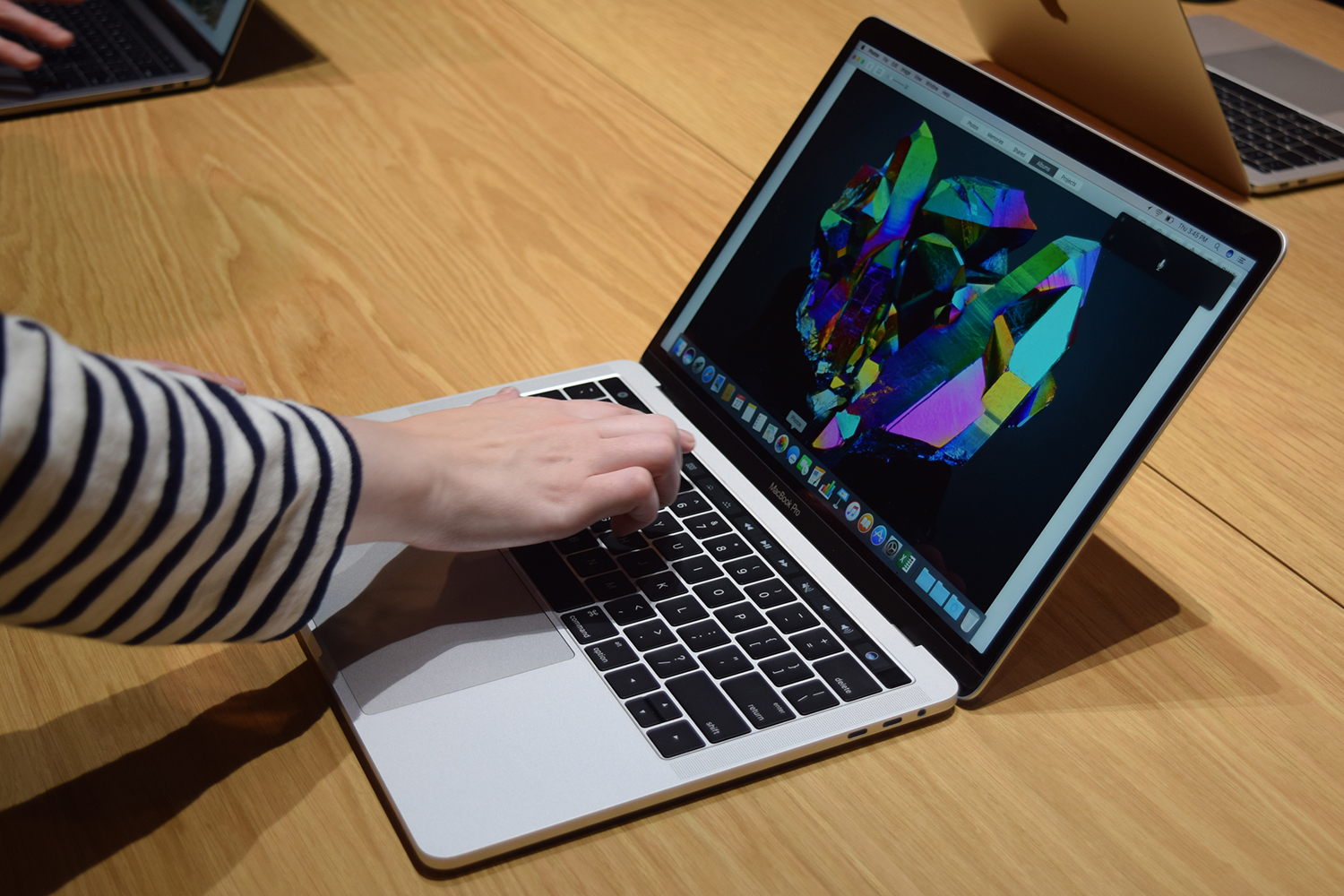There are quite a few premium laptops that can outperform the MacBook Pro 15, but it’s tough to compete with Apple’s build quality and engineering expertise. The MacBook Pro 15 might be expensive, but as a luxury device it has few competitors. Well, it had few competitors, until Microsoft released its Surface Book 2.
The Surface Book 2 is slick, well-built, and every bit as expertly engineered as the MacBook Pro 15. In a lot of ways, it’s the culmination of Microsoft’s pursuit of premium hardware, and it might even be slick and stylish enough to sway some MacOS die-hards. Let’s dig into the details to find out for sure in our Surface Book 2 vs. MacBook Pro 15 battle royale.
Specifications
|
MacBook Pro 15 with Touch Bar |
Microsoft Surface Book 2 15-inch |
|
| Dimensions | 13.75 x 9.48 x 0.61 (in) | 13.5 x 9.87 x 0.57-0.9 (in) |
| Weight | 4.02 pounds | 4.2 pounds |
| Keyboard | Full-size backlit keyboard | Full size backlit keyboard |
| Processor | Up to ninth-generation Intel Core i9 | Up to eighth-generation Intel Core i7-8650U |
| RAM | 16GB | 16GB |
| Graphics | AMD Radeon Pro 555X w/ 4GB of RAM AMD Radeon Pro 560X w/ 4GB of AMD Radeon Pro Vega 16 w/ 4GB of AMD Radeon Pro Vega 20 w/ 4GB of |
Nvidia GeForce GTX 1060 w/ 6GB of |
| Display | 15.4-inch LED-backlit display with IPS technology | 15-inch LED-backlit display with IPS technology |
| Resolution | 2,800 x 1,800 (220 ppi) | 3,240 x 2,160 (259 ppi) |
| Storage | Up to 4TB PCIe-based onboard SSD | Up to 1TB PCIe SSD |
| Networking | 802.11ac, Bluetooth 5.0 | 802.11ac, Bluetooth 4.1 |
| Ports | 4x Thunderbolt 3 USB-C | 2x USB-A ports, 1 USB-C port, 3.5mm headphone jack, 2x Surface Connect ports, SDXC card reader |
| Webcam | 720p FaceTime HD camera | 5.0MP 1080p front-facing camera, 8.0MP 1080p rear-facing autofocus camera |
| Operating System | MacOS Catalina | Windows 10 |
| Battery | 83.6 watt-hour | 90 watt-hour combined |
| Price | Starts at $2,399 | Starts at $1,699 |
| Availability | Now (Apple Store) | Now (Microsoft Store) |
| Review | 3 out of 5 | 4 out of 5 |
Design
Sitting on a table, closed, both laptops are striking. The MacBook Pro exemplifies a slimmed down streamlined elegance, an artistic refinement of the traditional laptop. The Surface Book 2, on the other hand, looks like something from the future.
Both devices feel solid and sturdy, like they were machined from a single solid piece of aluminum — or in the Surface Book’s case, magnesium. There’s no give, no flex, nothing moves when it shouldn’t. Both devices feature strong, stable hinges, and killer build quality.
The Surface Book 2 has a trick up its sleeve, though. The display detaches from the base to become a fully featured Surface tablet. When used as such it offers full support for the Surface Pen and Surface Dial.
This versatility means the Surface Book 2 works how you want it to. Lying on a couch, or sitting at desk, the Surface Book 2 is designed to fit your needs. The MacBook Pro 15 offers an excellent desktop and laptop user experience, but you can’t exactly pop its screen off and read a book while lying in bed.
Performance
Looking at processor performance, the MacBook Pro 15 actually has a leg up on the Surface Book 2. We reviewed the MacBook Pro 15 with Intel’s 9th-generation i9 chip inside. According to Geekbench, the MacBook Pro 15’s processor earns a score of 5,423 in single-core performance and 29,708 in multi-core performance. The Surface Book 2’s 8th-generation processor hits 4,547 in single-core performance, and 13,900 in multi-core performance.
What does that mean, in practice? Although the two devices are fairly close in terms of single-core performance, the MacBook Pro blasts the Surface Book 2 out of the water when it comes to multi-core workloads. Things like video processing will benefit hugely from its i9 processor. The MacBook Pro 15 doesn’t come with the i9 by default; instead, you’ll get an i7. Although we haven’t been able to test this in the latest model yet, the fact that it’s a six-core chip should still give it the edge over the Surface Book 2’s quad-core i7 processor.
But let’s be fair. Opting for that high-end i9 processor makes the MacBook Pro noticeably more expensive than the Surface Book 2. The i9-equipped MacBook Pro 15 is $500 pricier than the i7 Surface Book 2 when kitted out with identical memory and storage. There’s a massive gulf in class between these two processors, but with great performance comes great expense. When you’re paying over $2,000 for a laptop you’re hardly going to be pinching the pennies, but it’s still a hefty cost to bear. You’ll need to decide if you need that superior firepower.
Apple’s 2019 updates to the MacBook Pro 15 now mean it’s much more able to compete with the Surface Book 2 when it comes to graphical performance. While Microsoft’s device will easily pull ahead of the AMD 555X GPU in the baseline MacBook Pro 15, the AMD Vega 20 you can outfit it with will give the Nvidia GTX 1060 in the Surface Book 2 stiffer competition. That said, the 1060’s extra 2GB of memory should give it more wiggle room than the Vega 20.
Display

When it comes to display quality, Apple is hard to beat. Their slick glassy displays possess a clarity and depth that very few manufacturers can compete with. Given how well Microsoft has done with the Surface Book 2 so far, it might be a close contest.
Looking at display contrast — the difference between the darkest part of the screen and the brightest part — the Surface Book 2 has a solid lead over the MacBook Pro 15, and that’s impressive.
The Surface Book 2 hit a contrast ratio of 1,410:1 in our tests, while the MacBook Pro 15 topped out at 990:1. Both are stellar scores, and lend each display a unique sense of depth and character, but the Surface Pro 2 wins this round. Let’s see how they do with display gamut and color accuracy.
When it comes to display gamut — the breadth of colors the display is capable of reproducing — the MacBook Pro 15 wins hands down. Hitting 91 percent of the finicky Adobe RGB spectrum, the MacBook Pro 15 easily outpaces the Surface Book 2, which came in at 71 percent.
Apple’s displays are typically professional-grade, so their color accuracy is typically hard to beat. And that’s definitely the case here. The MacBook Pro 15 scores an impressive 0.8 average color error. Any score less than 1.0 is considered almost impossible to see with the naked eye, so that’s excellent.
The Surface Book 2, on the other hand, hit an average color error of 3.96. The colors are vibrant, but a bit too vibrant. With a score like that, the Surface Book 2 features color issues that are definitely noticeable to the naked and untrained eye.
Portability
There are really two facets you need to look at when you’re comparing the portability of different devices: Form factor and battery life. A laptop’s form factor, its size and its weight play an important role in how “carryable” it is. Whether or not you’ll really feel it depends on whether you carry it around in a bag everywhere you go or just around the office.
In that way, the MacBook Pro 15 has a bit of a leg up based solely on its dimensions. It’s thinner and lighter than the Surface Book 2. It’s a narrow margin, but the MacBook Pro 15’s uniform thickness and slightly lighter body make for a laptop that’s easier to tote around.
There’s another important component here, though. When it comes to battery life, the typically best-in-class MacBook Pro 15 falls short of the Surface Book 2’s impressive, unbelievable longevity — and it should. That’s because the MacBook Pro 15 has one battery tucked in under the keyboard, while the Surface Book 2 has a battery in the display — for the tablet portion — and a larger battery underneath the keyboard, for a whopping total of 90 watt-hours of battery life. The MacBook Pro 15 features a 83.6 watt-hour battery.
According to manufacturer estimates, that means the MacBook Pro 15 can last about 10 hours of wireless web browsing. During our testing of the Surface Book 2, it managed an impressive 15 hours of wireless web browsing.
Software
Here’s the thing about comparing MacOS to Windows: It’s a moot point. These days there are so few software exclusives — not including games — that you can get just about any software suite on Windows or MacOS. Both platforms are quick, modern, and stylish, and they each have their own weird eccentricities.
This one is solely a matter of preference, and it’s so easy these days to install Windows on a Mac that the division between these two diametrically opposed operating systems is becoming less and less important.
Bottom line
The overall winner is the Surface Book 2, due to its versatile design and unbelievable longevity. It’s also one of the few laptops that’s able to come close to the MacBook Pro’s superb build quality and premium feel. When you buy a Surface Book 2, you feel how high-end it is.
It’s not an easy victory, however. The MacBook Pro’s Intel i9 processor is incredibly powerful and simply destroys the Surface Book 2’s i7 chip. You may be surprised to learn that if you max out the Surface Book 2 — i7 processor, 1TB SSD, 16GB of memory — you can actually get the same specs plus the superior i9 processor in the MacBook Pro, all for the exact same price. It’s not often that happens with Apple products, but it makes the MacBook Pro 15 a very tempting option if you need that extra power.
Whichever you opt for, you’ll be getting a top-of-the-line device that should handle your needs with ease. The versatility and unrivalled battery life of the Surface Book 2 just wins the day in our eyes, though.
Editors' Recommendations
- The XPS 16 is fighting an uphill battle against the MacBook Pro
- MacBook Pro 16 vs. MacBook Pro 14: The important differences
- Best refurbished MacBook deals: Get a MacBook Air for $140 and more
- Best MacBook deals: Get an Air for $605 and save on M3 MacBook Pro
- Best Apple deals: Save on AirPods, Apple Watch, iPad, MacBook






